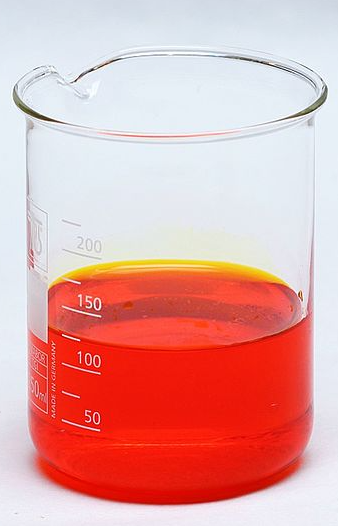Potassium dichromate is one of the most widely used chemical reagents in inorganic chemistry. It primarily serves as a strong oxidising agent in various chemical reactions in laboratories and industries. Potassium dichromate is an important chemical widely used wherever oxidation is involved. It is also one of the most important compounds of chromium.
Potassium dichromate is always handled with great precautions and care as it poses health hazards to humans if exposed for a long time. It has a very bright red-orange colour appearance and is found in an ionic solid crystalline state. Potassium dichromate is widely used in analytical chemistry and industries as it is non-deliquescent in nature compared to other industrially important salts like sodium dichromate.
Potassium dichromate, also referred to as potassium salt, is the dipotassium salt of dichromic acid. The preparation of potassium dichromate is commonly done by using chromates, and these chromates are formed by the reaction of chromite ore with sodium/potassium carbonate. We will look at various aspects of potassium dichromate in detail below.
Table of Contents
- Properties of Potassium Dichromate
- Preparation of Potassium Dichromate
- Potassium Dichromate Uses
- Potassium Dichromate Health Hazards
Overview
| IUPAC name | Potassium dichromate(VI) |
| Other names | Potassium bichromate
Bichromate of potash Dipotassium dichromate Dichromic acid, dipotassium salt Chromic acid, dipotassium salt |
| Chemical formula | K2Cr2O7 |
| Molar mass | 294.185 g/mol |
| Appearance | Red-orange crystalline solid |
| Odour | odourless |
| Density | 2.676 g/cm3, solid |
| Melting point | 398 °C (748 °F; 671 K) |
| Boiling point | 500 °C (932 °F; 773 K) decomposes |
| Solubility in water | 4.9 g/100 mL (0 °C)
13 g/100 mL (20 °C) 102 g/100 mL (100 °C) |
| Solubility | Insoluble in alcohol, acetone |
Potassium Dichromate Formula and Molecular Structure
The chemical formula for potassium dichromate is K2Cr2O7, and the molar mass is calculated to be 294.185 g/mol. It is an ionic compound with two potassium ions (K+) and the negatively charged dichromate ion (Cr2O7-), in which two hexavalent chromium atoms (with oxidation state +6) are each attached to three oxygen atoms as well as a bridging oxygen atom.
Occurrence
Potassium dichromate is found naturally as a rare mineral known as lopezite. It is said to have been obtained as vug fillings in the nitrate deposits of the Atacama Desert of Chile as well as in the Bushveld igneous complex of South Africa.
Properties of Potassium Dichromate
Physical Properties of Potassium Dichromate
- Potassium dichromate has the appearance of red-orange crystals and normally exists in a solid state at room temperature.

- It is odourless.
- It is non-combustible, and also its nature is highly corrosive.
- The density of potassium dichromate in the solid state is 2.676 g/cm3.
- Its melting point is 398 °C (748 °F; 671 K), while its boiling point is 500 °C (932 °F; 773 K). It decomposes on boiling.
- The solubility of potassium dichromate in the water at different temperatures is 4.9 g/100 mL at 0 °C and 13 g/100 mL at 20 °C and 102 g/100 mL at 100 °C, which means it becomes highly soluble in water at higher temperatures. On the other hand, it is insoluble in alcohol, acetone.
- The refractive index of potassium dichromate is 1.738.
- Its crystalline structure is triclinic, and the coordination geometry for the central atom chromium is tetrahedral.
Chemical Properties of Potassium Dichromate and Reactions
1. Action of Heat
K2Cr2O7 shows decomposition when heated to liberate potassium chromate, and the evolution of O2 gas is also observed.
The reaction can be depicted as follows:
4K2Cr2O7 → 4K2CrO4 + 2Cr2O3 + 3 O2
2. With Alkalies
The orange-red colour of the K2Cr2O7 solution turns into a yellow colour when potassium dichromate reacts with alkalies. This yellow colour is because of the formation of potassium chromate.
The reaction proceeds as follows:
K2Cr2O7 + 2KOH → 2K2CrO4 + H2O
Orange-red Yellow
Again, the yellow colour of K2CrO4 converts to orange-red when acidified because of the formation of K2Cr2O7.
2K2CrO4 + H2SO4 → K2Cr2O7 + K2SO4 + H2O.
Orange-red
This colour change from orange to yellow and yellow to orange can be explained by the concept of equilibrium of the two ions. In the potassium dichromate solution, Cr2O72- ions (in orange colour) are in equilibrium with CrO42- ions (in yellow colour ).
Cr2O72- + H2O ⇋ 2CrO42- + 2H+
Orange-red Yellow
3. Oxidising Properties
Potassium dichromate is one of the most powerful oxidising agents. One mole of K2Cr2O7 liberates three moles of oxygen when reacted with dil.H2SO4.
The reaction can be depicted as follows:
K2Cr2O7 + 4 H2SO4 → K2SO4 + Cr2 (SO4)3 + 4H2O + 3(O)
A few more illustrations of oxidising properties of K2Cr2O7 are listed below:
- It liberates I2 from KI. The reaction is as follows:
K2Cr2O7 + 7H2SO4 + 6KI → 4 K2SO4 + Cr2 (SO4)3 + 3 I2 + 7H2O
- Ferrous salts are oxidised to ferric salt by potassium dichromate.
The equation for this reaction is as follows:
K2Cr2O7 + 7H2SO4 + 6 FeSO4 → K2SO4 + Cr2 (SO4)3 + 3 Fe2 (SO4)3+ 2H2O
- Hydrogen sulphide is oxidised to sulphur by this compound.
The equation for this reaction is as follows:
K2Cr2O7 + 4H2SO4 + 3H2S → K2SO4 + Cr2 (SO4)3 + 7H2O + 3S
4. Chromyl Chloride Test
When potassium dichromate and concentrated sulphuric acid are reacted with salt-containing chloride, reddish-brown vapours of chromyl chloride are evolved.
This reaction is also popularly known as the “chromyl chloride test”.
The equation for this reaction is:
K2Cr2O7 + 4KCl + 6H2SO4 → 2CrO2Cl2 + 6 KHSO4 + 3H2O
Chromyl Chloride
The above reaction is widely employed in the salt analysis of chloride ions.
Preparation of Potassium Dichromate
Preparation of potassium dichromate from chrome iron ore
A step-by-step process for the preparation of K2Cr2O7 from its ore is explained below:
i) Conversion of chrome iron ore to sodium chromate
The ore is first converted to a powdered form and then blended with sodium carbonate Na2CO3 and CaO (quick lime). Then it is heated inside a reverberatory furnace in the presence of sufficient amounts of air. The reaction occurring in this step can be written as:
4FeO.Cr2O3 + 8Na2CO3 + 7O2 → 8Na2CrO4 + 2Fe2O3 + 8CO2
ii) Conversion of Na2CrO4 to Na2Cr2O7
From the first step, we get a sodium chromate solution. This sodium chromate solution is purified properly by the process of filtration so as to remove iron oxide and other impurities. It is further reacted with concentrated H2SO4, which results in the conversion of sodium chromate into sodium dichromate.
2Na2CrO4 + H2SO4 → Na2Cr2O7 + Na2SO4 + H2O
iii) Conversion of sodium dichromate into potassium dichromate
In the final step, the sodium dichromate obtained from the previous step is concentrated and heated. Then, this hot, concentrated solution of sodium dichromate is reacted with potassium chloride KCl, which results in the formation of potassium dichromate.
The reaction for this step can be written as follows:
Na2Cr2O7 + 2KCl → K2Cr2O7 + 2NaCl
Potassium dichromate is sparingly soluble in water as compared to sodium chloride NaCl. Due to this, potassium dichromate separates out in the form of crystals on cooling.
Potassium Dichromate Uses
The important uses of potassium dichromate in industries are as follows:
- Potassium dichromate is mainly used in the production of potassium chrome alum and in the leather tanning industry.
- Potassium dichromate can be used as a raw material for the manufacturing of chromic acid, which is used as an etchant for glass materials and also for the purpose of cleaning glassware. Nowadays, its use is very limited because of its hazardous nature.
- It is also used in the construction industry as an ingredient in cement, where it increases the hardening time of the concrete mixture and improves its density and colour.
- In the photography industry, it is used as an oxidising agent and in photography screen printing.
- It is also used as a hardening agent for organic solvents like gelatin, dye, carbon black and gum Arabic. These hardened solvents find their uses in the creation of metal printing plates used in photomechanical printing processes.
- The solution of potassium dichromate solution with dilute H2SO4 is used for the development of negatives in photography.
- It is used in screen printing photography because it has the property of tanning leathers and skin on exposure to light.
- Potassium dichromate acts as an excellent chemical reagent in analytical chemistry because of its non-hygroscopic properties. One of the major uses is in the determination of the concentration of ethanol.
- One important application for potassium dichromate is in old police breathalyzer tests for the determination of drink and drive cases. When alcohol vapour makes contact with the orange dichromate-coated crystals, the colour changes from Cr(VI) orange to Cr(III) green. The degree of the colour change is directly related to the level of alcohol in the suspect’s breath.
- Schwerter’s solution (solution of 35% nitric acid and potassium dichromate) is used for the analysis of various metals and their purity. This is more common for silver, so it is called the silver test. It also gives different colours for different purity grades of silver.
- Potassium dichromate paper is widely used for the analytical test of sulfur dioxide, as it gives a cloud change from orange to green.
- It is also widely used for the staining, polishing and tanning of wood, which gives it a glossy finish with a rich brown texture.
Potassium Dichromate Health Hazards
- Potassium dichromate is highly carcinogenic. Prolonged exposure to this compound can cause severe damage to respiratory organs and even death in some cases.
- Even a small amount of consumption of this salt can prove fatal. It has been found that a dose of 40 grams or more leads to immediate death and heavy side effects in the human body.
- As it is highly corrosive in nature, it burns the inner lining of the stomach and intestines if consumed.
- Symptoms of illness, such as excess urination and vomiting and loose motion, are generally seen after its light exposure or consumption.
- The potassium ion present in this compound has been known as the cause of heart diseases, such as low blood pressure, heartbeat malfunction, heart attack and choking off blood veins.
- Long-term exposure to potassium dichromate by construction workers causes skin diseases. Skin also gets burnt by its corrosive nature.
- The compound is also corrosive, and exposure may produce severe eye damage or blindness. Prolonged exposure of the human body to this compound leads to reproductive disease, loss of fertility in males, genetic disorders and harm to unborn children.
Related Video


Comments